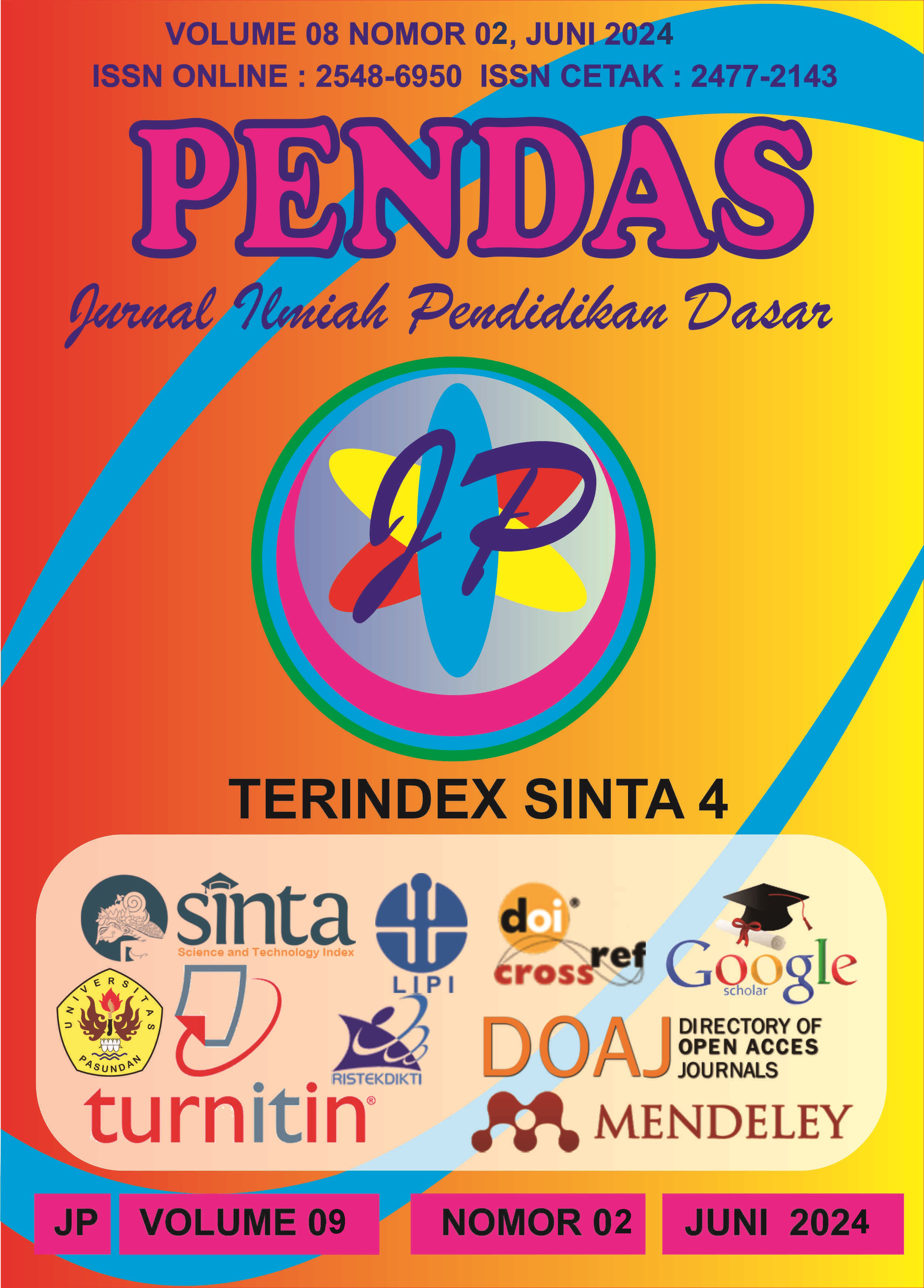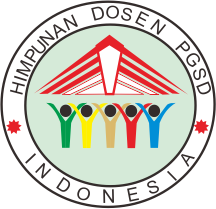ANALISIS BIBLIOMETRIK: KREATIVITAS MELALUI KEGIATAN BERMAIN
DOI:
https://doi.org/10.23969/jp.v9i2.14779Keywords:
Bibliometric analysis 1, Creativity 2, Play 3Abstract
Abstract: Creativity includes high-level thinking skills as part of the 21st century skills that students must have which encourage individuals to produce creative ideas. This article is a bibliometric analysis of scientific literature in the field of education. This article presents articles about "creativity and games" from 2014 to 2024 based on the Google Scholar database. The selected metadata is then analyzed and visualized with VosViewer software. Based on the results of the analysis, several interesting results were found. Firstly, there has been no collaboration between Indonesian authors and other research on this matter. Second, based on the analysis of results in the last ten years there has been no research using bibliometrics with the keywords "creativity and games". Publications regarding creativity and play have been published since 1959 and from 2014-2024 have increased significantly. This is because researchers' attention to creativity as a 21st century skill is increasing and one of them is done through playing activities. This can be used as additional research by researchers for further research. Abstrak: Kreativitas termasuk keterampilan berpikir tingkat tinggi sebagai bagian dari keterampilan abad 21 yang harus dimiliki siswa yang mendorong individu untuk menghasilkan ide-ide kreatif. Artikel ini merupakan analisis bibliometrik terhadap literatur ilmiah di bidang pendidikan. Artikel ini menyajikan artikel mengenai “creativity and play” dari tahun 2014 hingga 2024 berdasarkan database google scholar. Metadata yang dipilih kemudian dianalisis dan divisualisasikan dengan software VOSviewer. Berdasarkan hasil analisis ditemukan beberapa hasil yang menarik. Pertama belum ada kolaborasi yang terjadi antara penulis Indonesia dengan penelitian lain terkait hal ini. Kedua, berdasarkan hasil analisis dalam waktu sepuluh tahun terakhir belum ada penelitian menggunakan bibliometrik dengan kata kunci “creativity and play”. Publikasi mengenai kreativitas dan bermain ini telah diterbitkan sejak tahun 1959 dan dari tahun 2014-2024 meningkat secara signifikan. Hal ini karena perhatian peneliti terhadap kreativitas sebagai keterampilan abad 21 meningkat dan salah satunya dilakukan dengan kegiatan bermain. Hal ini dapat dijadikan pertimbahan oleh peneli untuk dijadikan penelitian selanjutnya.Downloads
References
Andersen, N. (2021). Mapping the expatriate literature: a bibliometric review of the field from 1998 to 2017 and identification of current research fronts. International Journal of Human Resource Management, 32(22), 4687–4724. https://doi.org/10.1080/09585192.2019.1661267
Celume, M. P., Besançon, M., & Zenasni, F. (2019). Fostering children and adolescents’ creative thinking in education. Theoretical model of drama pedagogy training. In Frontiers in Psychology (Vol. 9, Issue JAN). Frontiers Media S.A. https://doi.org/10.3389/fpsyg.2018.02611
Clark, E. V. (2020). Perspective-taking and pretend-play: Precursors to figurative language use in young children. Journal of Pragmatics, 156, 100–109. https://doi.org/10.1016/j.pragma.2018.12.012
Dere, Z. (2019). Investigating the creativity of children in early childhood education institutions. Universal Journal of Educational Research, 7(3), 652–658. https://doi.org/10.13189/ujer.2019.070302
Hallinger, P., Wang, R., Chatpinyakoop, C., Nguyen, V. T., & Nguyen, U. P. (2020). A bibliometric review of research on simulations and serious games used in educating for sustainability, 1997–2019. In Journal of Cleaner Production (Vol. 256). Elsevier Ltd. https://doi.org/10.1016/j.jclepro.2020.120358
Hudha, M. N., Hamidah, I., Permanasari, A., Abdullah, A. G., Rachman, I., & Matsumoto, T. (2020). Low carbon education: A review and bibliometric analysis. In European Journal of Educational Research (Vol. 9, Issue 1, pp. 319–329). Eurasian Society of Educational Research. https://doi.org/10.12973/eu-jer.9.1.319
Kumar, R., Saxena, S., Kumar, V., Prabha, V., Kumar, R., & Kukreti, A. (2023). Service innovation research: a bibliometric analysis using VOSviewer. In Competitiveness Review. Emerald Publishing. https://doi.org/10.1108/CR-01-2023-0010
Kupers, E., Lehmann-Wermser, A., McPherson, G., & van Geert, P. (2019). Children’s Creativity: A Theoretical Framework and Systematic Review. Review of Educational Research, 89(1), 93–124. https://doi.org/10.3102/0034654318815707
Martins, J., Gonçalves, R., & Branco, F. (2022). A bibliometric analysis and visualization of e-learning adoption using VOSviewer. Universal Access in the Information Society. https://doi.org/10.1007/s10209-022-00953-0
Mochizuki, T., Sasaki, H., Wakimoto, T., Kubota, Y., Eagan, B., Hirayama, R., Yamaguchi, Y., Yuki, N., Funaoi, H., Suzuki, H., & Kato, H. (2022). Mediating and perspective-taking manipulatives: Fostering dynamic perspective-taking by mediating dialogic thinking and bolstering empathy in role-play and reflection for microteaching. International Journal of Computer-Supported Collaborative Learning, 17(4), 489–518. https://doi.org/10.1007/s11412-022-09382-w
Nandiyanto, A. B. D., & Al Husaeni, D. F. (2021). A bibliometric analysis of materials research in Indonesian journal using VOSviewer. Journal of Engineering Research (Kuwait), 9. https://doi.org/10.36909/jer.ASSEEE.16037
Andersen, N. (2021). Mapping the expatriate literature: a bibliometric review of the field from 1998 to 2017 and identification of current research fronts. International Journal of Human Resource Management, 32(22), 4687–4724. https://doi.org/10.1080/09585192.2019.1661267
Celume, M. P., Besançon, M., & Zenasni, F. (2019). Fostering children and adolescents’ creative thinking in education. Theoretical model of drama pedagogy training. In Frontiers in Psychology (Vol. 9, Issue JAN). Frontiers Media S.A. https://doi.org/10.3389/fpsyg.2018.02611
Clark, E. V. (2020). Perspective-taking and pretend-play: Precursors to figurative language use in young children. Journal of Pragmatics, 156, 100–109. https://doi.org/10.1016/j.pragma.2018.12.012
Dere, Z. (2019). Investigating the creativity of children in early childhood education institutions. Universal Journal of Educational Research, 7(3), 652–658. https://doi.org/10.13189/ujer.2019.070302
Hallinger, P., Wang, R., Chatpinyakoop, C., Nguyen, V. T., & Nguyen, U. P. (2020). A bibliometric review of research on simulations and serious games used in educating for sustainability, 1997–2019. In Journal of Cleaner Production (Vol. 256). Elsevier Ltd. https://doi.org/10.1016/j.jclepro.2020.120358
Hudha, M. N., Hamidah, I., Permanasari, A., Abdullah, A. G., Rachman, I., & Matsumoto, T. (2020). Low carbon education: A review and bibliometric analysis. In European Journal of Educational Research (Vol. 9, Issue 1, pp. 319–329). Eurasian Society of Educational Research. https://doi.org/10.12973/eu-jer.9.1.319
Kumar, R., Saxena, S., Kumar, V., Prabha, V., Kumar, R., & Kukreti, A. (2023). Service innovation research: a bibliometric analysis using VOSviewer. In Competitiveness Review. Emerald Publishing. https://doi.org/10.1108/CR-01-2023-0010
Kupers, E., Lehmann-Wermser, A., McPherson, G., & van Geert, P. (2019). Children’s Creativity: A Theoretical Framework and Systematic Review. Review of Educational Research, 89(1), 93–124. https://doi.org/10.3102/0034654318815707
Martins, J., Gonçalves, R., & Branco, F. (2022). A bibliometric analysis and visualization of e-learning adoption using VOSviewer. Universal Access in the Information Society. https://doi.org/10.1007/s10209-022-00953-0
Mochizuki, T., Sasaki, H., Wakimoto, T., Kubota, Y., Eagan, B., Hirayama, R., Yamaguchi, Y., Yuki, N., Funaoi, H., Suzuki, H., & Kato, H. (2022). Mediating and perspective-taking manipulatives: Fostering dynamic perspective-taking by mediating dialogic thinking and bolstering empathy in role-play and reflection for microteaching. International Journal of Computer-Supported Collaborative Learning, 17(4), 489–518. https://doi.org/10.1007/s11412-022-09382-w
Nandiyanto, A. B. D., & Al Husaeni, D. F. (2021). A bibliometric analysis of materials research in Indonesian journal using VOSviewer. Journal of Engineering Research (Kuwait), 9. https://doi.org/10.36909/jer.ASSEEE.16037
Nyhout, A., & Ganea, P. A. (2019). The Development of the Counterfactual Imagination. Child Development Perspectives, 13(4), 254–259. https://doi.org/10.1111/cdep.12348
Nyirahabimana, P., Minani, E., Nduwingoma, M., & Kemeza, I. (2022). A scientometric review of multimedia in teaching and learning of physics. In LUMAT (Vol. 10, Issue 1, pp. 89–106). University of Helsinki. https://doi.org/10.31129/LUMAT.10.1.1634
Riahi, Y., Saikouk, T., Gunasekaran, A., & Badraoui, I. (2021). Artificial intelligence applications in supply chain: A descriptive bibliometric analysis and future research directions. In Expert Systems with Applications (Vol. 173). Elsevier Ltd. https://doi.org/10.1016/j.eswa.2021.114702
Storage, D., Charlesworth, T. E. S., Banaji, M. R., & Cimpian, A. (2020). Adults and children implicitly associate brilliance with men more than women. Journal of Experimental Social Psychology, 90. https://doi.org/10.1016/j.jesp.2020.104020
Supriadi, U., Supriyadi, T., Abdussalam, A., & Rahman, A. A. (2022). A Decade of Value Education Model: A Bibliometric Study of Scopus Database in 2011-2020. European Journal of Educational Research, 11(1), 557–571. https://doi.org/10.12973/EU-JER.11.1.557
Thompson, B. N., & Goldstein, T. R. (2019). Disentangling pretend play measurement: Defining the essential elements and developmental progression of pretense. In Developmental Review (Vol. 52, pp. 24–41). Mosby Inc. https://doi.org/10.1016/j.dr.2019.100867
Zhou, Z., Zhang, H., Li, M., Sun, C., & Luo, H. (2021). The Effects of Zhongyong Thinking Priming on Creative Problem-Solving. Journal of Creative Behavior, 55(1), 145–153. https://doi.org/10.1002/jocb.441
Zhu, W., Shang, S., Jiang, W., Pei, M., & Su, Y. (2019). Convergent Thinking Moderates the Relationship between Divergent Thinking and Scientific Creativity. Creativity Research Journal, 31(3), 320–328. https://doi.org/10.1080/10400419.2019.1641685
Downloads
Published
Issue
Section
License
Copyright (c) 2024 Pendas : Jurnal Ilmiah Pendidikan Dasar

This work is licensed under a Creative Commons Attribution 4.0 International License.



















